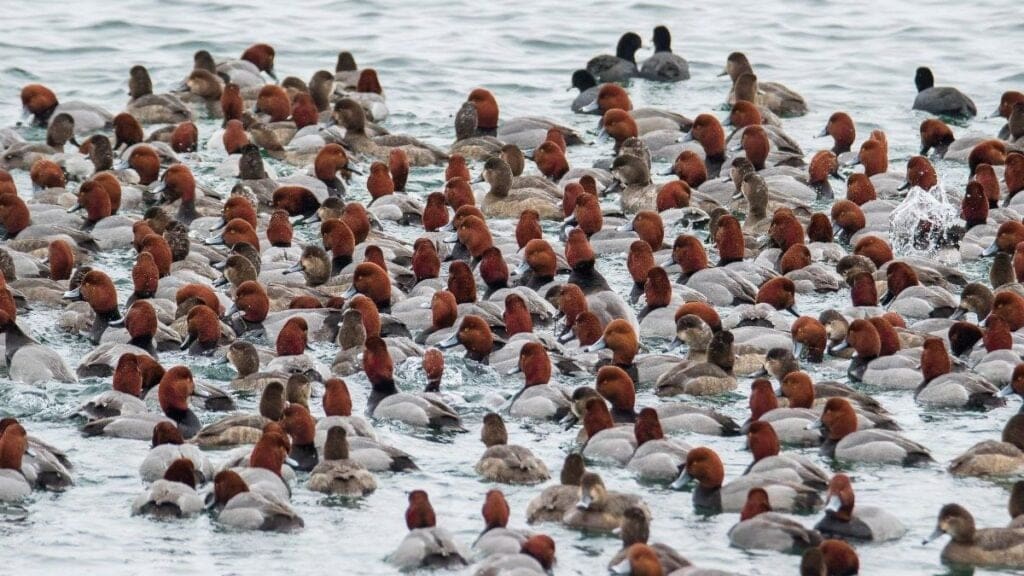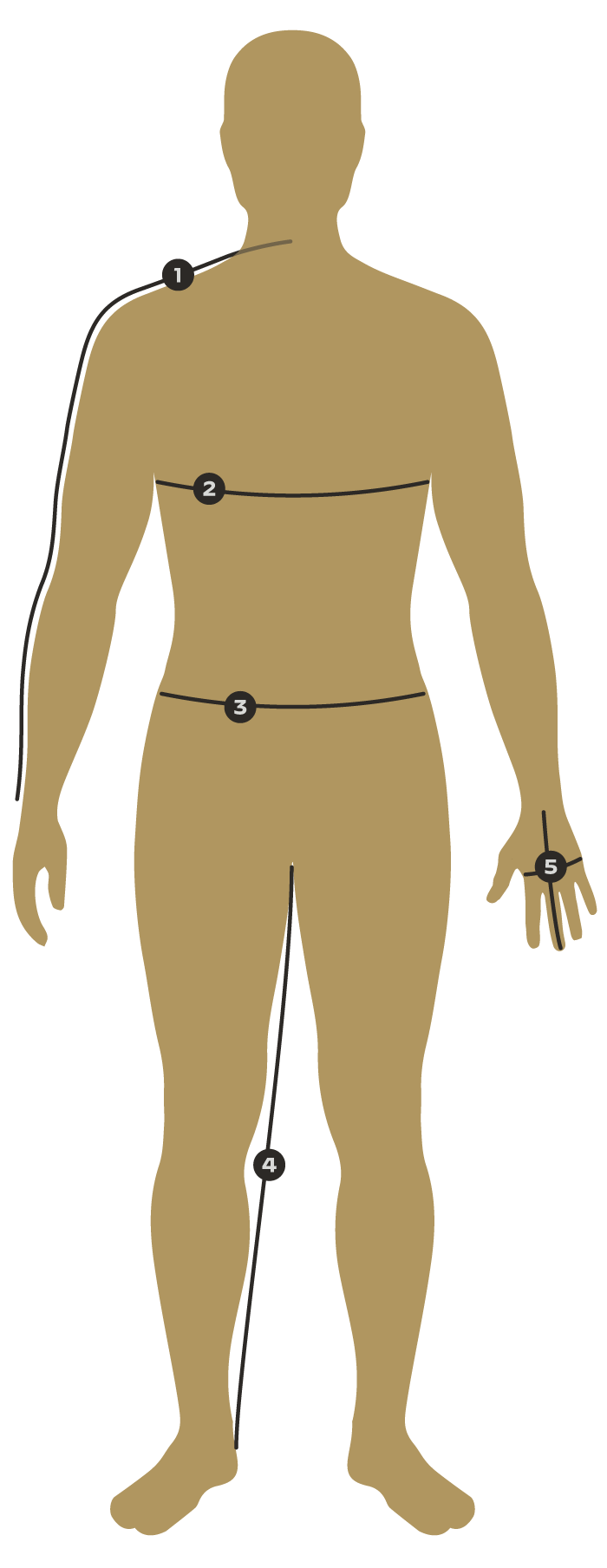Hunting large bodies of water is a commitment, but the results can be oh-so rewarding.
When it comes to hunting preferences, waterfowl hunters run the gamut from jumping drainage ditches for cornfed mallards to paying thousands of dollars to hunt eider in the open Pacific Ocean, and of course everything in between, which is where most hunters fall in.
There are a lot of advantages to stripping away all the extraneous gear and logistics and being content to bag a few birds occasionally, but many hunters eventually find themselves moving deeper into the realm of hardcore waterfowl hunting, which typically requires a substantial investment. Big water hunting falls into the “spendy” category.
Why hunt big water? There are a host of reasons, but most commonly it’s a simple matter of access, and many hunters do not have access to ponds and marshes, or maybe they’ve grown weary of crowded public areas and complicated leases.
This leaves big water. While it is nearly always public, there is a lot more room to roam and additional logistics preclude many hunters to some degree. Hunting big lakes and rivers requires a boat, ideally large decoys spreads, as well as other the other necessities that go along with it.
There are a several options for hunting big water, but the most common are semi-permanent blinds such as a pontoon anchored offshore, permanent shoreline blinds, and boats with pop-up style blinds. In addition, a select group of hunters also hunt via layout boats that require a tender boat, which is very popular with diving duck hunters.
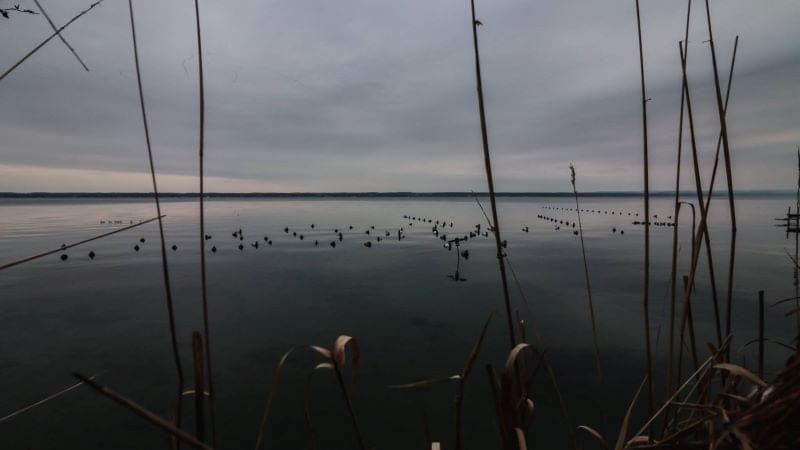
Why Hunt Big Water:
- Waterfowl love big water for roosting, loafing, and feeding
- Wider variety of species
- Migrating waterfowl are attracted to big water
- Less competition
- Easier access
Drawbacks of Hunting Big Water:
- More gear intensive and nearly always requires a boat
- Can be challenging to decoy waterfowl roaming such a large area
- Potential exposure to dangerous conditions
- Ideally requires more than one hunter, so not the best solo option
- Harder to scout and takes more time to understand
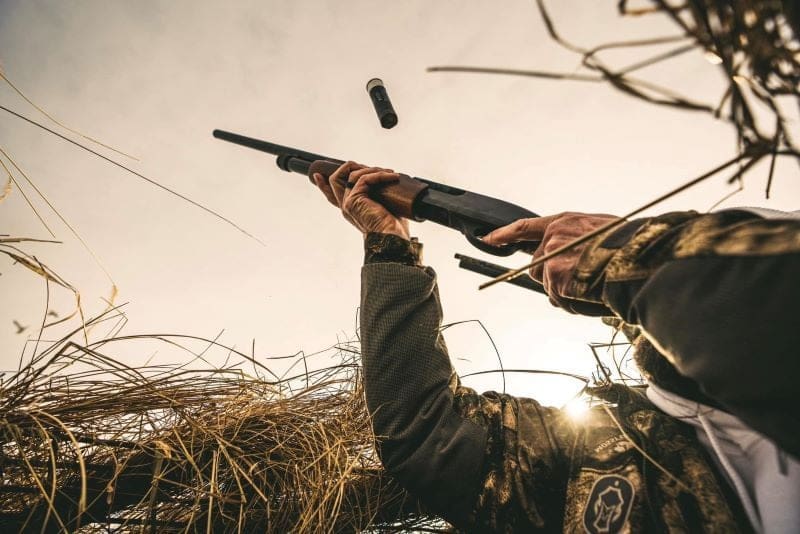
Basic gear includes some sort of watercraft, and the options are diverse. Most hunters use either a Jon-boat or a deep-v style boat. Watercraft designed to serve double-duty as seasonal fishing or hunting boats are very popular. Depending on the style of hunting, a removable pop-up or permanent blind fitted to the boat is important for concealment. The exception being when you’re able to hide the boat in shoreline vegetation or timber.
Decoys are mandatory for big water hunting. This is a great opportunity to roll out the red carpet, so to speak, and set huge decoy spreads with multiple species. Oversized decoys work great for this application and mixing species with lots of white helps too. Bluebills, canvasbacks, goldeneye are excellent additions to a big water spread whether you expect to see those species or not. On the other end of the spectrum, dark decoys show up great by adding contrast. Again, whether you expect to see them or not, black ducks mixed in with mallards add a lot of pop to the spread.
Rigging decoys properly and using the right anchors is also critical. While you may have a lot of decoys rigged with short anchors such as Texas rigs, other than shallow water near shore, these decoys will be a liability in deeper water. It’s common to have depths over 5- or 6-feet near shore, and often much deeper depending on where you hunt. Big water decoys on individual lines should have a minimum of 6-ounces of weight and plenty of line to add “scope”, or anchor line angle, so the decoys don’t move around in heavier wave action.
Another option is longline rigs, which consist of an individual short “drop” from the decoy with a commercial fishing longline clip attached. This allows the decoys to be quickly clipped to a mainline that is anchored to the bottom. Each anchor line can hold as many decoys as you like, and you can stagger the spacing to add more realism to the spread. Diver hunters use these rigs almost exclusively because setting and pickup is efficient due to the lack of long individual anchor lines, which speeds up setting huge spreads.
There is some method to the madness when it comes to “pulling” ducks and geese to a big water decoy spread, and one of the important elements is to expand the overall footprint and leave lots of empty space for birds to land. Big water hunters are known to run the spread further out than other sets in smaller water. It’s common to have decoys 60 – 80 yards out, and occasionally further. The furthest out may be sparse, but the closer you get to the blind the denser the spread becomes. Most of the time, birds want to be where the party is and will slide through the rest of the spread to get to the densely decoyed areas well-within gun range. It may be counter-intuitive to set decoys well out of range, but sometimes that is what it takes to improve the odds of birds seeing your decoys.
Consider putting your cleanest, best decoys near the shooting position, and set the B-team decoys out further. Movement should also be closer to the blind, but not necessarily directly downwind of the blind where birds will setup behind spinning wings while staring right at you as you watch them approach. Setting movement off the side a tad draws the bird’s attention away from human faces and inevitable movement. Note, too, that the larger the flock the more eyeballs scanning for threats, making concealment vitally important.
Except for diver hunting, calling is very important also. Open water sort of eats up the sound of duck calls and louder duck calls work better. If there ever was a place to hammer on a flock of ducks a quarter mile out with a loud call, this is it. Of course, there are days when you don’t need to “lean on ‘em”, but after a good day of big water hunting with straps full of greenheads to show for it, your lips and cheeks may be a little sore from high-balling migrating flocks with a loud single reed.
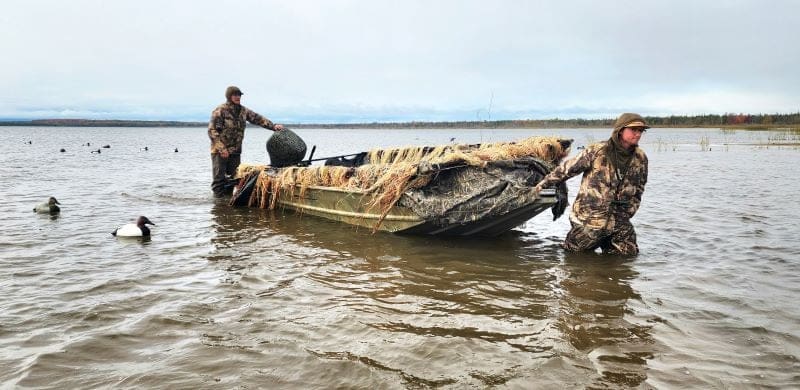
One of the most important factors to consider is safety, and sadly, each season waterfowl hunters are lost to open water. The number one reason for drowning is the victim not wearing a PFD (personal flotation device). Hunters are particularly lax in this regard, which may have something to do with wearing bulky clothes and not having comfortable life jackets. Figure that out prior to hitting the water!
Duck boats are chronically overloaded and underpowered. This is very common, especially when hunters use a smaller boat that is usually deployed for marsh and pond duty, but big water can whip into a frenzy quickly and without additional “freeboard” to keep the vessel from taking on water. The risk of swamping is greatly increased, and unless there are other hunters nearby for a rescue, it’s a terrible time to go into the water. In the event of a disaster, wear your life jacket and stay with the boat if it’s offshore. Incidentally, decoy bags full of floaters can offer some additional floatation.
Make sure your cell phones are fully charged and in a waterproof container. Check weather and marine forecast prior to and during the hunt, and don’t make assumptions. If your boat is not up to the challenge stay home or go someplace else. It simply isn’t worth the risk.
